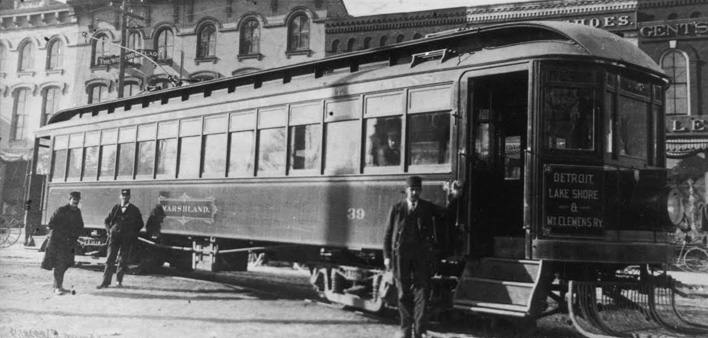(from the Summer, 2017 issue of Macomb Now Magazine)
By Denis LeDuc
As a very young boy growing up in the 1950s, I was close to my grandparents. They lived in the flat above my parents and my older brother and I in our two-story house on Balfour Street in Detroit. When my mother got tired of minding me, she would send me upstairs to visit with my grandmother and grandfather. Fired up by my grandparents’ stories, I dreamt of growing up to be a railroad engineer. My grandparents told tales of my great-grandfather, who had been a conductor on the Wabash Railroad. They also told of traveling on the Interurban Rail, referring to it as the Rapid Railway System. As a child I imagined that it was a real railroad running through the heart of Detroit and out into Macomb County and beyond.
In the early 1900s, my grandparents regularly took the Interurban, which was in fact more of a streetcar than a railroad. My grandmother was a self-taught artist and she would travel from Detroit to Macomb County to sketch and paint the countryside. My grand father would travel the Interurban to go fishing in lake St. Clair. I particularly remember one photograph of my grandfather and four to five men with a rope strung out between them, full of perch.
Construction began on the Interurban Rail in the mid-1890s. The railcars were self-propelled and powered by overhead electric lines. Serving Macomb County was a rail line that ran from Detroit along Jefferson Avenue, through the Grosse Pointes and St. Clair Shores, along the lake to Mount Clemens. That line was he one my grandfather took to fish. Another line ran out Gratiot Avenue through Roseville to Mount Clemens and there was service through Rochester to Washington Township and to the Village of Romeo. Passengers could ride from Mount Clemens to Chesterfield and New Baltimore and even to Port Huron.
Our photograph is of an Interurban railcar on Gratiot Avenue (now Main Street) in downtown Mount Clemens, circa 1901. On the upper left of the photo, atop the building, is a sign for the Weather Flag Drug Store, which was located at 19 N. Gratiot. Below the sign, arching up from the back of the car, is the electrical arm going to the overhead power lines. Notice our uniformed crewman on the right, his foot resting near the steel rail. Above him, a passenger can be seen in the window. On the front of the car is the designation Detroit, Lakeshore and Mount Clemens Rd., just above the ”cow catcher.” Notice the headlamp, also on the front of the car. On its side, the rail car, No. 39, is named “The marshland.”
With the birth and boom of the automobile, the Interurban gave way to passenger cars and was dismantled and completely gone by 1930. But many city planners today are discussing efficient, pollution–free, light–rail systems, a modern city planner’s dream come alive – circa 1900 in Macomb County.
Photo courtesy of the Mount Clemens Library Historical Collection.


